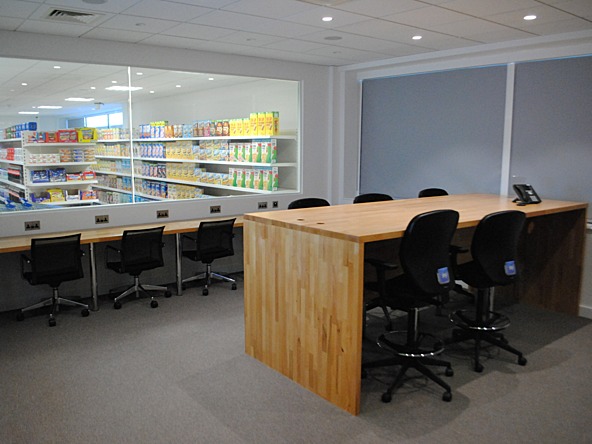Setting up shop: creating the ultimate retail environment for brands

Imagine having a retail environment where you could trial how consumers interact with a brand’s packaging and point-of-purchase offer in real time. Consumer insights business PRS IN VIVO has made this a reality at its state-of-the-art facility in the town of Bromley, on the border of Kent and Southeast London.
The concept of the retail lab – a space with shelves stacked with a range of FMCG goods including hair products, cereals and alcohol that looks for all the world like a regular minimart – was the brainchild of French CEO Olivier Blanchet back in 2005.
The Bromley facility is joined by two others in the UK, one in Newcastle (the largest, at 300 square metres) and another in Watford. The company also has 20 labs around Europe, throughout Italy, Spain, Germany and France, as well as in Russia and the US.
Location is key
Andy Rushforth, senior vice-president of market development for PRS IN VIVO’s UK business, describes the facility as “our heartland”, meaning that it represents a real USP for the company.
He explains the rationale behind the choice of locations: “We make sure to be no farther than 50 metres from the high street in an area with a good, balanced demographic and high footfall.” The company hires local staff to assist them in recruiting suitable shoppers, offering them an incentive based on the length of a particular session.
The staff will carry out a brand profile test check to ensure that the participants are a good fit for their requirements. If they qualify, they will be given a trolley, a shopping list and mission, and directed to pay attention to the price point even if they don’t have to pay for anything at the checkout.
Analysing shopper behaviour
This is as close to the real shopping experience as possible, according to Rushforth, “minus the queues and the distractions”. It’s a controlled environment with a two-way mirror and sound proofing between the shoppers and those analysing their behaviour. Along with the supermarket, there is a suite of online testing rooms.
The PRS IN VIVO team carefully scrutinises the participants’ behaviour to see what the drivers of purchasing decisions are, using a hi-tech eye-tracking device that enables them to observe their subconscious behaviour.
“We can see exactly what the shopper is looking at and for how long they are looking at any specific product, plus any particular elements of the packaging that they are drawn to, such as the brand name, product imagery, or claims”, elaborates Rushforth. He recalls working with soft drink multinational PepsiCo when it wanted to determine how prominent its claim about recyclable packaging should appear on the can.
An invaluable approach
Such full-scale comprehensive testing does not come cheap, but it is worth the investment maintains Rushforth, who goes on to provide several examples of where such an approach is invaluable. “The first reason is the finish of the product, as in the look of the packaging, whether that’s embossed or using metallic ink, or so forth.”
The second element is around the topic of sustainability in cases where manufacturers are trying to reduce or replace plastic windows in their blister packs – like batteries or razors for instance. “Conducting these sessions in person provides participants with a tactile approach”, notes Rushforth.
The retail lab also comes into its own when manufacturers seek to change pack size, such as downsizing chocolate bars. While this is difficult to detect on screen, “it is much more visceral in real life”, he maintains. The lab can also be of help in the context of companies looking to nudge shopper behaviour change in terms of packaging format, such as washing detergent manufacturers steering customers away from powder towards liquid or capsules.
Cross-category research
Another service offered is shopper-based studies for products that do not naturally fit into any one category in the retail environment as they may be a kind of hybrid, such as adult wet wipes or a non-alcoholic fruit beer. In the instance of the fruit beer, it could be marketed differently depending on the context; it might be placed alongside other low-alcohol beverages in the store’s drinks section, or positioned as a lunchtime refreshment at the sandwich counter.
PRS IN VIVO presents retailers with their product learnings to enable them to get inside the mindset of the shopper and the team works across all product categories. One recent example of cross-category research was on behalf of confectionery manufacturers to best mitigate compliance with the government’s new HFSS regulations.
Rushforth believes that choosing to use the retail lab is money well spent because packaging has to work harder now than in the heyday of classic advertising back in the 1980s, when brands were more visible. Nowadays, apart from social media recommendations, he observes that most shoppers discover new products on the supermarket shelf.
“It really is ‘the first moment of truth’, as Procter & Gamble termed it”, says Rushforth, referring to the moment a consumer chooses a product over other competitors’ offerings when standing front of the retail fixture. The retail lab provides manufacturers with “their very own playground”, he concludes.

We hope you enjoyed this article.
Research Live is published by MRS.
The Market Research Society (MRS) exists to promote and protect the research sector, showcasing how research delivers impact for businesses and government.
Members of MRS enjoy many benefits including tailoured policy guidance, discounts on training and conferences, and access to member-only content.
For example, there's an archive of winning case studies from over a decade of MRS Awards.
Find out more about the benefits of joining MRS here.














0 Comments